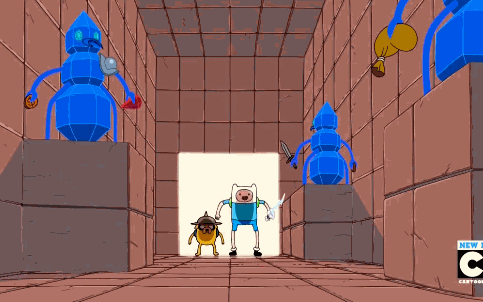Dungeons in Fate: Scenes and Scenarios
Oct. 22, 2016, 4:34 p.m.
I have recently been thinking a lot about how to do fantasy well in Fate. I just rewatched The Fellowship of the Ring and played in a five-session game of Dungeons and Dragons 5e that my friend ran, both of which fueled my thoughts on the subject. One thing in particular that I have focused my thoughts on is dungeons. I personally really enjoy the idea of dungeons and exploring them as an adventuring party. I enjoy the mystery, the exploration, the crazy monsters, and the challenge.

Dungeons and Dragons does this in it's own way, but Fate is a very different game than D&D and warrants a different approach. Fate doesn't worry about the fiddly bits or whether you turn right down this corridor or left down the other. Instead, Fate focuses on the story. So I'm going to do a series of blog posts on tips for running a dungeon in Fate. For this first post, we'll be talking about scenes and scenarios.
Using scenes and scenarios
First of all, some dungeons may be small and inconsequential. They may just be a backdrop during a chase scene or something along those lines. For that setup, it is perfectly fine to go through a dungeon in a single scene or roll, but if you and your players are looking for that dungeon-delving feel, make it into a whole session or even a scenario instead.
As a scenario of its own, it allows you to bring the players deep into the unknown and really allow for some exploring. You can convey the mood of the dungeon through each individual scene and provide a meaningful conclusion to it.
The real meat in this approach is in the individual scenes. In classic dungeon crawls, the players explore the entire map of the dungeon and often find something in every room they enter. Personally, I think that's boring, and I would guess that you do too if you're reading my blog about Fate. So instead of giving the players a ton of choices of which way to turn or which door to open, just narrate the parts that don't have anything interesting going on. You can still use descriptive language and/or visuals to convey the mood and themes of the dungeon. Then, frame each interesting location or room as a scene in and of itself.
In order to be an interesting location it must add to the story, but even showing how dangerous the dungeon is with a deadly battle can count as story. Think about the theme of the dungeon and the mood you want to set. You obviously shouldn't fill it with a string of combats. Instead, try to make each room different, create a story with it, and have each scene build off of the previous one.
Example: The Mines of Moria
The Lord of the Rings example of a dungeon is obviously the Mines of Moria. Since Fate models fiction, the Mines of Moria are a great example of how we can model a dungeon in Fate. Here is a write up of the scenes and how they went through the lense of a Fate game.
- Scene 1 - Entering the Dungeon: Gandalf tries an overcome to open the door into the mines. He fails the roll and succeeds at a cost. The cost is that it took long enough that the hobbits got bored and threw rocks into the pond outside, awakening the monster in the water. When Frodo finally figures out the password of "Friend," the door opens, and they enter and discover the mines to be a tomb. Then, the lake monster wakes up, battles them and destroys their only exit. That last bit was probably a compel to send them deeper into the mountain.
- Montage of heroes walking (This is when you describe and narrate.)

- Scene 2 - Crossroads: So I know I said Fate doesn't worry about whether
you go to the left or right corridor, but there are exceptions. In this scene,
Gandalf is either compelled or he succeeds at a cost again on a Lore roll to
navigate. Either way, he is stuck sitting there not knowing where to go. Now, the reason this is an interesting scene is not because of the decision to go right or left. Gandalf ends up eventually taking the path that smells better because it was so inconsequential. Instead, this scene is interesting because it gives Frodo a chance to notice that Gollum is following them. - Montage of heroes walking
- Scene 3 - Balin's Tomb: The heroes enter the tomb of Balin, Gimli's cousin, and Gandalf starts reading a record of what happened there. While he does, Pippin is compelled by his Fool of a Took aspect to touch the skeleton and accidentally knock it into the well, awakening the hoards of goblins below. A battle takes place. The heroes make it out with only a few scratches. Then, more goblins come.
- Scene 4 - The Chase: The hoards of goblins that approach are far too many for the heroes to fight, so they run. A contest takes place in which the goblins end up winning, surrounding the heroes. Once again, the heroes succeed at a cost when the goblins suddenly turn and run as the Balrog approaches.
After that, the heroes run some more, have an encounter with the crumbling ruins, and then Gandalf faces the Balrog where he concedes in exchange for the party's safe passage. I'm not going to elaborate on those because I think I have said enough to get the point across. Dungeons can work in Fate, and they can work really well. Framing dungeons as a series of scenes that build off of each other is a great way to do this. So, I hope that helps as a start. Next time, I'll talk about how to use traps in your Fate dungeon.
As a disclaimer, these are just my thoughts on the subject, and this is not necessarily the only or even the best way to run dungeons in Fate. Just thoughts from one Game Master to another. How have your Fate dungeons gone? Can you think of any other examples of scene-based dungeons?
Tags: dungeons fate core tips ttrpg
Older Post Newer Post
Copyright © 2018, Nathan Hare
All rights reserved
